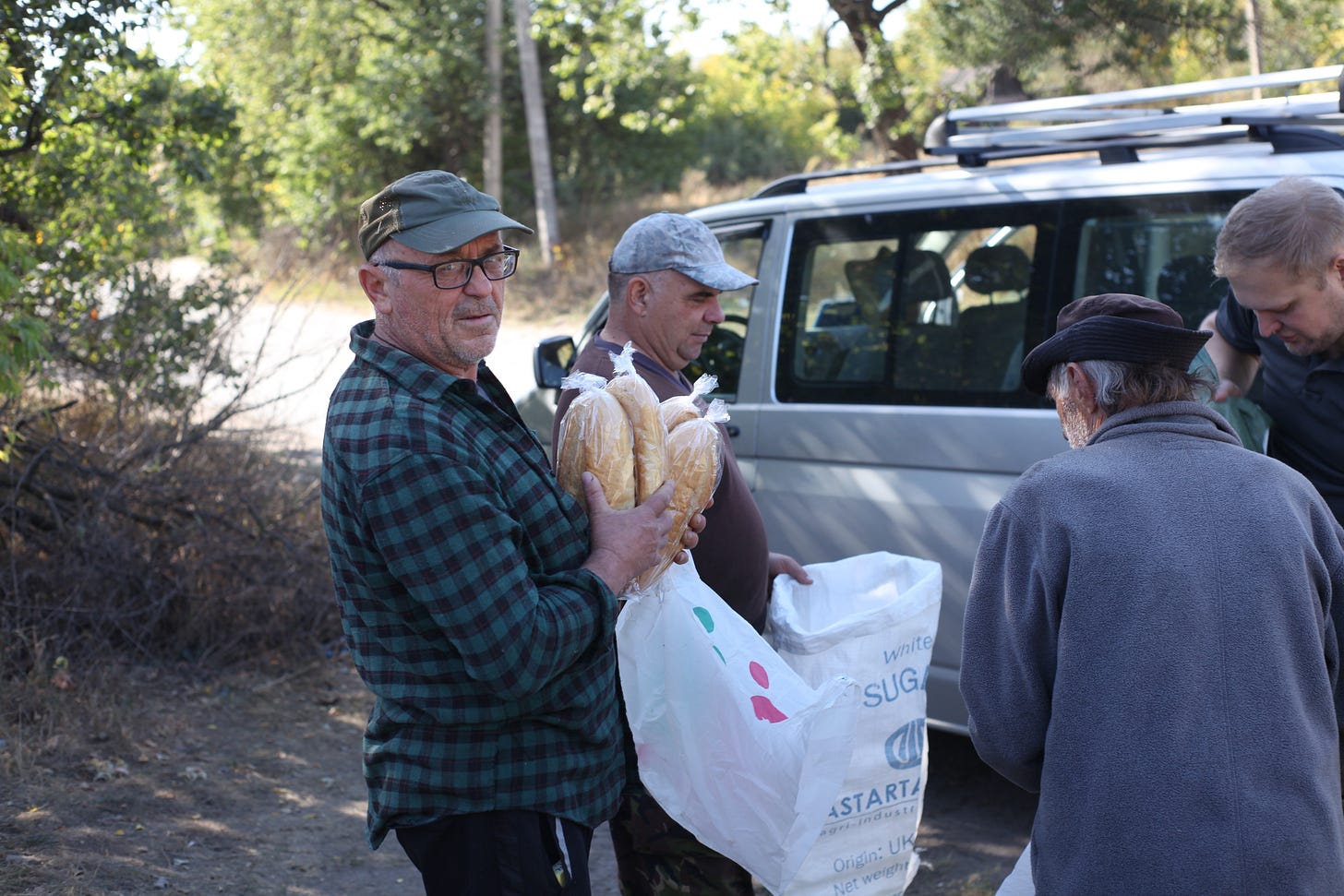Those who stayed in The Zone
Bringing aid to villagers in the gray zone behind the frontline, where Kyiv's authority is not anymore, but Moscow's has not yet arrived. The power of soldiers and necessity remain.
As the bread van pulls over for the umpteenth times to give space for the ambulance carrying wounded soldiers coming from the front at breakneck speed, Ivan's phone ring out.
“Where are you? You should have arrived an hour ago,” a female voice says with nervous trepidation. Ivan assures her that their village will be the next stopping point for his van, where he will unload a portion of the 150 kilogram bread he plans to distribute in the neighboring villages before noon.
Ivan is a humanitarian worker bringing bread every week to Yampil and Zakitne, once thriving villages northeast of Kramatorsk.
His arrival means not only the daily bread for the locals, but marks the passing of time and gives them a sense of stability, security, and predictability.
“War does not arrive in a village when the first drone hits, but when the last policeman, shopkeeper or family doctor leaves,” he says. “Being seen, recognized, and cared about is just as important for them as the bread I’m delivering.”
Yampil, along with other once-thriving villages in the Donbass region, swiftly declined after pro-Russian separatists, backed by Moscow, launched their insurgency against the Kyiv government ten years ago.
Their hardships were only exaggerated by Moscow’s full-scale invasion in 2022, after which they were briefly occupied only to be liberated by Ukrainian forces along with much of Kharkiv’s territory in the fall of the same year.
The handful of residents that chose to remain grew accustomed to live their life to the background noise of artillery duels 5–10 kilometers from them, totally dependent on external help, as there is no electricity and water, and shop-owners fled a long time ago.
"I have elderly parents who live in the next village, and as their daughter it is my duty to look after them," says Viktoria, a former teacher at the local school whose building now stands with windows broken by shock waves.
Everywhere in Ukraine, as the frontline approaches, state services are replaced by the presence of soldiers, and within a few weeks the people living here become citizens of the so-called "gray zone". In this zone, Kyiv's authority is no longer exclusive, but Moscow's has not yet arrived. The rule of soldiers and necessity prevail.
A discreet sign on a house with “300”, written on it, the radio code for wounded, signals the location of one of the stabilization points in the village, where the speeding vans can unload their bleeding cargo.
Half-buried military jeeps, camouflaged with netting, form a parallel line next to the villagers' houses.
Here not only Ukraine’s and Moscow’s authority become blurred, but the line distinguishing civilian from military, public and private property.
In Yampil, some houses have chalked inscriptions on the fences saying “full” indicating that soldiers decided to set up their sleeping quarters there. In gardens, mechanics in green pants sweat bent over fixing engines in the unusually warm late-September sunshine.
“These people are cut off from the outside world, there is no cell sign, only a couple of residents have internet access. But if I show up, they feel reassured: things are still can’t be that bad,” Ivan says.
As he passes between the two villages, burnt trunks of the trees in the surrounding forests are visible up to the height of two meters as aftermaths of the constant forest fires caused by the incoming shells during the summer.
"I make sure I go every week, and preferably at the same time. If I don’t, they panic. I’m the last one who cares about them,” Ivan says.
He can’t stay for long in one place and has to make several stops in one village to avoid generating crowds due to the constant presence of Russian drones in the air.
As in most places in Ukraine, discussion and agreeing on the number of explosions during the night and their cause replaced the topic of weather in small-talks. This is no different in Zakitne, where villagers greet Ivan as a friend and line up in the garden of the only house which has internet access.
They tell him who fled, and accurately list which houses were hit during the last week. Ivan listens to them attentively and gives them encouraging words.
Just as he finishes with handing out the last pieces of bread, buzzing is heard overhead - villagers quickly disperse, and he also gets back to his car. Here, he can drive fast. The usual dirt road that he is used to drive on was recently replaced by smooth asphalt to allow matériel to travel more quickly to the front and the wounded back.
“I fear the worst,” Ivan says, who stopped delivering aid to Chasiv Yar as it became too dangerous earlier this year. “The fact that they renovated the road signals something is boiling here.”
Judging by the holes hiding explosives drilled into the fresh asphalt at a regular interval, they are to stop a quick Russian advancement. That would leave, once again, the villagers of Yampil and Zakitne, at Russia’s mercy.





